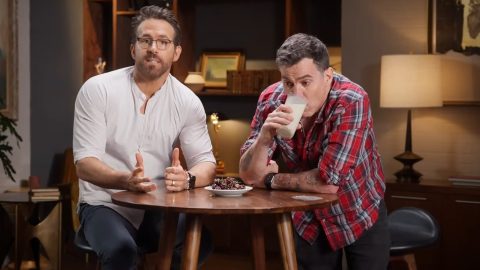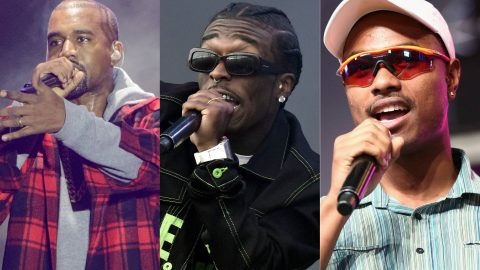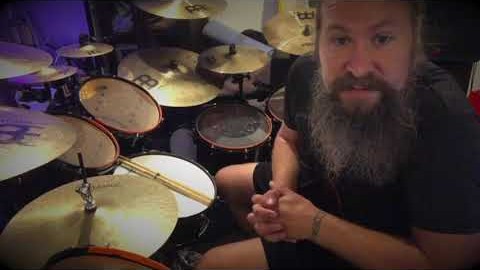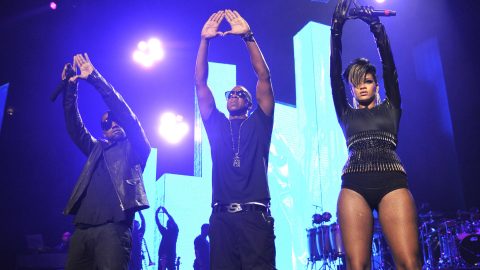
Meet Me In The Bathroom arrived in as much of a hurricane as the scene it eulogises did. Released in 2017, Lizzy Goodman’s oral history of NYC’s garage rock scene in the early noughties reignited the love for an era that had a bit of an image issue. Was there too much hype and bluster? Were any of the albums actually any good? The answers: yes, and yes.
With a healthy dollop of revisionism and sincerity, Meet Me In The Bathroom paid homage to the full range of characters that made the music, reinvigorated careers and brought in new fans. Many of the bands featured – The Strokes, Yeah Yeah Yeahs and LCD Soundsystem – have since reached career-highs some decades down the line, and can be almost-single-handedly credited with the emergence of the “indie-sleaze” phenomenon.
It was so successful, in fact, that it was adapted for a rowdy documentary of the same name, pairing the tunes and footage to some of the book’s most entertaining – and sordid – stories. It’s a film ripe to kick off NME Screens, an exclusive opportunity at London’s Rich Mix to see the film before it premieres in the UK. Find out more details about the event here.
Ahead of the event, we look back at the key albums that tell the story of the scene and what happened to the integral players next.
The Strokes – ‘Is This It’ (2001)
The record that kicked it all off. Few bands or albums become bywords for entire scenes, but, for better or worse, The Strokes and their debut did that. Released amidst feverish hype, the band meshed the old with the new; the sounds of Television and Richard Hell with a performance that relished antipathy amidst the chaos around them. The blueprint for a sound – and a scene – would begin here.
What NME said: “All you’ve heard is true. One of the best debut LPs by a guitar band in 20 years.”
What happened next: Depending on who you ask, ‘Is This It’ either marked the start or the end of something glorious. Follow-up albums ‘Room On Fire’ (2003) and ‘First Impressions Of The Earth’ (2006) took the band to arenas and inspired one Alex Turner to pick up a guitar, but inner-band drama would stand in the way of chasing those highs for nearly a decade. 2020’s ‘The New Abnormal’ would prove a career-best, however.

The Moldy Peaches – ‘The Moldy Peaches’
Adam Green and Kimya Dawson’s debut album was a glorious, spunky delight. Spearheading the haphazardly-named ‘anti-folk’ and ‘freak folk’ movement – both of which Green says had no real meaning or substance – the pair blended raw emotions, caustic wit and a decidedly DIY and lo-fi spirit. The album was released via Rough Trade on September 11, 2001.
What NME said: “Meet The Moldy Peaches – the latest in a short line of exciting new bands spending quality time in the gutter, ignoring the stars.”
What happened next: The band went on indefinite hiatus in 2004, three years before ‘Anyone Else But You’ would feature in Juno, where co-leads Elliot Page and Michael Cera sang the ditty to each other. Later this year, the band will reunite in London and at Primavera Sound in Barcelona for their first European performances in 20 years.
Fischerspooner – ‘#1’ (2001)
Meet Me In The Bathroom may appear dominated by bands with guitars, but its subjects were always united where they wanted their album to be heard: on the dancefloor. As Warren Fischer and Casey Spooner tell Goodman of their rowdy debut album, they wanted it to be “dangerous and messy”. Opinion would be split on the merits of the music (bores!), but their chaotic dabble in electroclash, and embracing the internet to promote their music, would prove prophetic.
What happened next: The band collaborated with David Byrne on their second album, and Michael Stipe on their final, ‘Sir’, before calling it quits in 2019.
Interpol – ‘Turn on the Bright Lights’ (2002)
Despite being written before the attack, ‘Turn on The Bright Lights’ became emblematic of the city’s post-9/11 malaise. ‘Is This It’’s ramshackle charm is replaced with broodiness and sincerity on Interpol’s debut, a record where sparse sounds chimed with a city still reeling. Unflattering comparisons to Joy Division and British post-punk bands would follow, but it was clear from the instrumental opener ‘Untitled’ that the band were destined to be so much more than mere pastiche.
What NME said: “Forget the New York state of mind: Interpol have crossed county lines into new, distinctly Mancunian territory. The electroclash ’80s have no place here – except maybe as a party heard through a thin and depressing partition wall.”
What happened next: 2004’s follow-up ‘Antics’ would prove equally successful, but trouble was brewing; in 2010, bassist Carlos Dengler left the group following the completion of their fourth record. The remaining trio continue touring and releasing records, their most recent being ‘The Other Side of Make Believe’ in 2022.

Yeah Yeah Yeahs – ‘Fever To Tell’ (2003)
If there was a sole winner from Meet Me In The Bathroom, it was Karen O. Goodman’s book and the ensuing film show how much of the scene’s vibrancy came from the Yeah Yeah Yeahs vocalist. It placed her sheer determination, vision and kindness in a scene constantly questioned and criticised by both those within, and the hangers-on who couldn’t quite grasp the appeal. ‘Fever To Tell’, a tenacious record that placed sincerity and fun at its core, would prove one of the era’s finest.
What NME said: “‘Fever To Tell’ reveals the Yeah Yeah Yeahs mixing up the cheap thrills with a grander plan: to build something substantial and special that’ll last long after the hormonal new wave has drifted out of fashion again.”
What happened next: The band stayed solid throughout the remainder of the decade; 2009’s ‘It’s Blitz’ conjured up mega hits in ‘Zero’ and ‘Heads Will Roll’. After a lengthy hiatus following 2014’s uneven ‘Mosquito’, last year they made a spectacular return with ‘Cool It Down’, co-produced by TV On The Radio’s Dave Sitek.
The Rapture – ‘Echoes’ (2003)
The group’s debut does offer more than just ‘House of Jealous Lovers’ and ‘Echoes’, but it’s hard to see past two of the decade’s most influential and thrilling songs. The fusion of rock and dance – one which frontman Luke Jenner needed convincing of – set a high benchmark, one which hooked DJs including Mark Ronson and the late Andrew Weatherall. The band fell victim to the scene’s snippiness and label interference, but when the songs landed on the dancefloor – including at the NME Awards Tour 2004 – that seemed to matter not one jot.
What NME said: “Find this place where dim rock/dance tribalism is an irrelevance, and all that matters is edgy, imaginative, emotionally resonant music.”
What happened next: ‘House of Jealous Lovers’ would rank sixth in NME’s songs of the decade. ‘Pieces of the People We Love’, a knotty follow-up, would arrive in 2006; the band would quietly split after ‘In The Grace Of Your Love’ in 2011. They reunited in 2019, playing a handful of shows in the US.
Franz Ferdinand – ‘Franz Ferdinand’ (2004)
By this point, the influence was being felt across the pond. The Glasgow-based art-rockers released ‘Darts of Pleasure’ as a single in September 2003 and sparked a label scramble for their debut, eventually won by Domino Records. It proved some kind of alchemy: they were equally inspired by The White Stripes and The Hives as they were by their local electronic scene at clubs like Optimo. Their masterpiece, ‘Take Me Out’, ushered in a new era of indie-rock in the UK, and sent the band to the world.
What NME said: “The latest and most intoxicating example of the wonderful pushing its way up between the ugly slabs of Pop Idol, nu metal and Britons aping American bands.
What happened next: This album bagged them the Mercury Prize, and an equally-massive sequel took them to the Grammys and beyond. On 2009’s ‘Tonight’, they embraced the weirder corners of electronic music, a place they’d feel most comfortable at for much of the following decade. A Greatest Hits collection was released in 2022.

LCD Soundsystem – ‘LCD Soundsystem’ (2005)
After years as a cheerleader for the scene via his DFA Records label, James Murphy entered the fray in 2002 with ‘Losing My Edge’, a delightfully spiky take on his perceived coolness among the city slickers. A self-titled debut would arrive three years later, armed with a UK Dance Number One in ‘Daft Punk Is Playing At My House’ and more fusions of electronic rhythms and rock bravado. They weren’t the first to attempt such a heady mix, but many 21st-century bands have tried – and often failed – to re-capture this album’s raw energy.
What NME said: “Dig this record not because it’s fashionable and cool, but because it’s the sound of a major new talent striving – and succeeding – to be original. Respect.”
What happened next: The following two albums – 2007’s ‘Sound of Silver’ and 2010’s ‘This Is Happening’ – would take the band to New York’s Madison Square Garden in 2011, which Murphy promoted as the band’s final-ever date. This was to prove temporary; the band reunited in 2016 and a year later would release ‘American Dream’, their fourth album. They remain a consistent presence on the live circuit.
TV On The Radio – ‘Return to Cookie Mountain’ (2006)
By the mid-noughties, the key players and sounds moved from the Lower East Side to Brooklyn, where TV on The Radio were cutting their teeth. Their sound was broader but just as punchy: ‘Wolf Like Me’ would have chart success in the US, UK and beyond. David Bowie was such a fan, he provided backing vocals for ‘Province’. A masterful meticulous collection from a band that would leave a long shadow on indie-rock.
What happened next: The record’s 2008 follow-up ‘Dear Science’ would garner further acclaim. Bassist Gerard Smith died in 2011 of lung cancer, nine days before the release of their fourth album ‘Nine Types of Light’. Dave Sitek has since become a prolific producer, working with Liam Gallagher, Beyoncé & Jay-Z and more. They last released music in 2014.

Vampire Weekend – ‘Vampire Weekend’ (2008)
From battered leather jackets to Lacoste polos and tank tops: by the arrival of Vampire Weekend towards the decade’s end, things were looking decidedly different. Formed at an Ivy League school and embracing (and gently mocking, they say) the East Coast elites, the group’s debut would prove a breath of fresh air. Once the immediate rush of ‘A-Punk’ wore off, their self-titled record ventured on strange, wonderful tangents, embracing chamber pop and Afropop influences.
What NME said: “Indulge in ‘Vampire Weekend’s vivid, foppish fantasy, which can still tell you plenty about the human condition, even if its lacrosse whites are rather suspiciously well-laundered.”
What happened next: Three classy records – ‘Contra’ (2010), ‘Modern Vampires of The City’ (2013) and ‘Father Of The Bride’ (2018) – would chart at Number One in the US. Co-founding member Rostam Batmanglij would leave the band in 2016, going on to produce records with Maggie Rogers, Clairo and Haim, as well as releasing solo music under his own name.
NME Screens: Meet Me In The Bathroom will take place on Thursday March 9 at Rich Mix in Shoreditch, London. Tickets are free, and sign-up is available via DICE.
Meet Me In The Bathroom will be released in UK and Irish cinemas from Friday March 10, and available to stream on demand from Monday March 27.
The post Meet Me In The Bathroom: the story of the scene in 10 key albums appeared first on NME.









